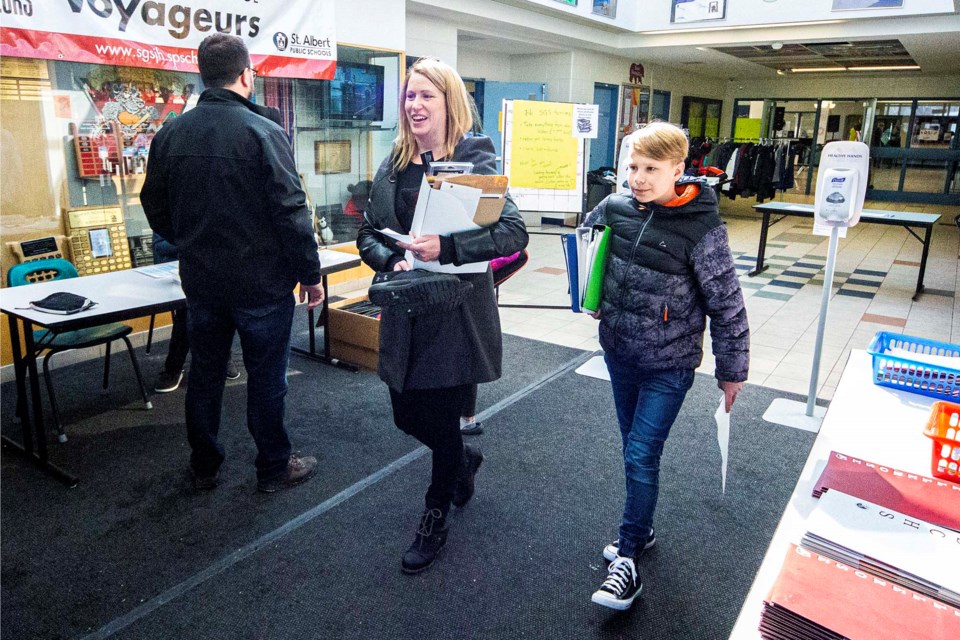Getting Alberta kids back to school this fall will be a start-and-stop experiment, says a U of A epidemiologist – one that could prove more risky to parents than students.
Alberta Education Minister Adriana LaGrange said May 6 that the province is working with teachers, school boards and parents on a plan to resume in-person classes this fall.
LaGrange cancelled all in-person classes at K-12 schools March 15 in response to the COVID-19 pandemic. Students have been learning at home ever since.
LaGrange said she does not plan to reopen schools this term as the province’s chief medical officer of health, Dr. Deena Hinshaw, had recommended that they stay closed indefinitely.
“No decision has been made on any aspect of the reopening plan,” she emphasized, and any decision would honour collective agreements and be subject to the approval by the chief medical officer of health.
LaGrange said the plan, which is still being drafted, will include three scenarios: one where schools reopen as normal, one where they reopen with health measures such as physical distancing, and one where they stay closed and students continue learning at home. Schools may have to switch between scenarios as the pandemic changes.
LaGrange said regardless of which scenario happens, the province would return the $128 million it took from schools earlier this year to address the pandemic this July 1 as promised, and that “every single school division will see an increase in their funding” this fall under the new funding formula.
LaGrange also announced Alberta Education had set up a help-line (780-422-6548) for parents with questions about at-home education, especially those with children with disabilities.
LaGrange said she hopes to have a draft plan ready within a few weeks.
Risk to kids?
LaGrange’s announcement comes as Quebec prepares to reopen most elementary schools on May 11 and after nations such as Denmark have had schools opened for several weeks.
University of Alberta epidemiologist Don Voaklander said he supports the province’s decision to keep schools closed until the fall, saying Quebec is moving far too quickly given its number of COVID-19 cases. As of Thursday, Quebec had reported more than 35,000 COVID-19 infections and 2,631 deaths.
“The real risk is not to the kids themselves but what they bring home to parents and seniors,” he noted.
Voaklander said researchers have found most of the victims of the novel coronavirus have been old or had chronic health conditions, with deaths and hospitalizations amongst youth extremely rare. That said, children can carry the disease, and bringing them together in school could speed its spread.
“There’s still a lot of uncertainty as to how many people have the disease,” he noted, as Alberta does not yet have the testing capacity to detect asymptomatic carriers.
Lessons from afar
St. Albert Public superintendent Krimsen Sumners said Alberta Education was to send out “a draft of the draft” reopening plan to boards sometime this week for discussion. The province confirmed last week schools would stay closed for the rest of this term.
“We would have loved to have the kids back,” she said, but there is maybe a month and a half of school left this term, and they would likely lose at least a week of class time getting the schools ready again.
Sumners said schools are keeping a close eye places such as Quebec, Denmark and Sweden for clues on how to safely bring kids back to school.
Denmark has cut class sizes in half and spread desks apart, for example, and is having kids wash their hands every hour. In Quebec, classes have been capped at 15 students each, with students having staggered recess times, taking turns using the schoolyard and staying two meters apart at all times (amongst other measures).
Sumners said it would be very tough for St. Albert Public to limit classes to 15 students each as its schools are already packed – they’d essentially need twice the schools and a lot more staff. That might mean having junior and senior high students learn at home so lower grades could use their classrooms.
“Busing is another can of worms,” she continued.
Quebec is asking parents to drive students to school where possible. Buses will have Plexiglas shields around drivers and will host one student per bench on every other bench.
St. Albert Public would need three times as many buses if it went one person per seat, and that would mean three times the cost, Sumners said – not easy when the board already has a transportation deficit. Having parents drive kids to class could create equity issues.
Voaklander said most nations that have reopened schools are having students come in on staggered schedules – half in the morning, half in the afternoon – and emphasized physical distancing and hand washing. Some had mandated mask use. Temperature screenings (to detect fevers, which are a symptom of COVID-19) were also possible.
It’s tough to say at this point what reopening schools will mean for public health, Voaklander said. Parents would have to be extra careful to stay away from the elderly or infirm, and might want to keep homeschooling their kids if they have someone with a compromised immune system in the family.
“Until there is a vaccine that’s widely available, this is going to be a stop-and-start experiment,” he said, with frequent changes to how schools operate.
Sumners was at a bit of a loss when asked what parents should do to get ready for this fall.
“We have to be prepared to be flexible,” was her advice.




